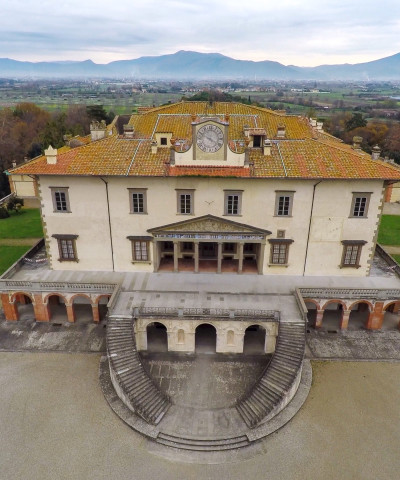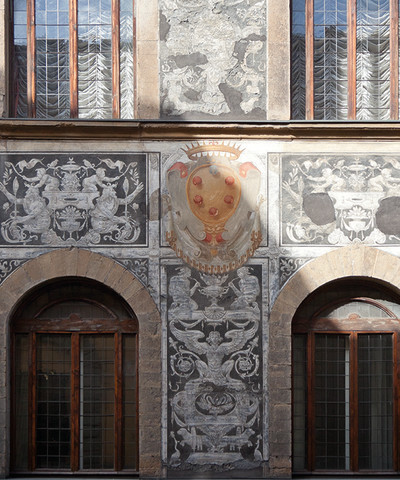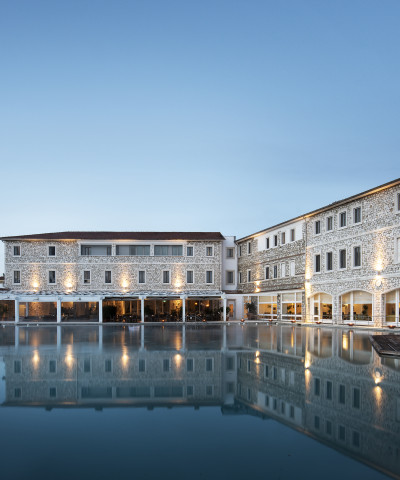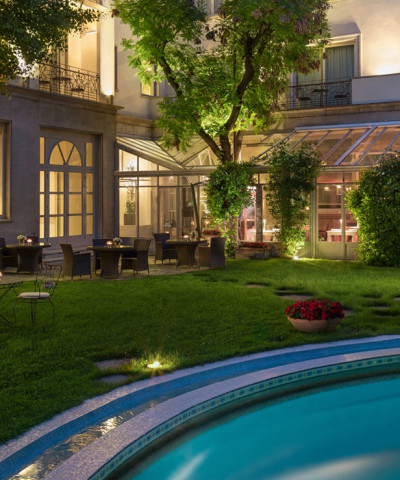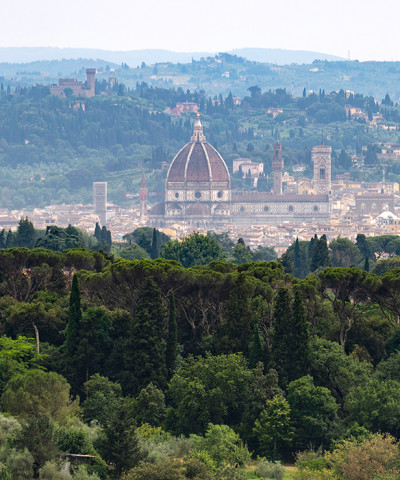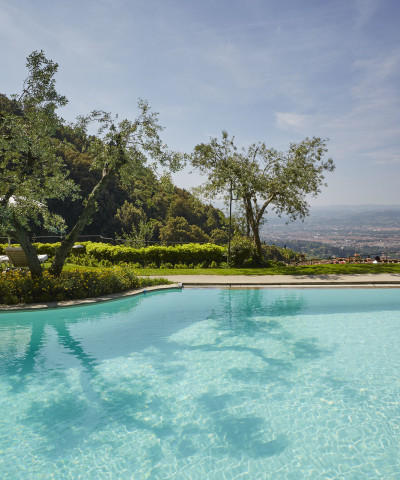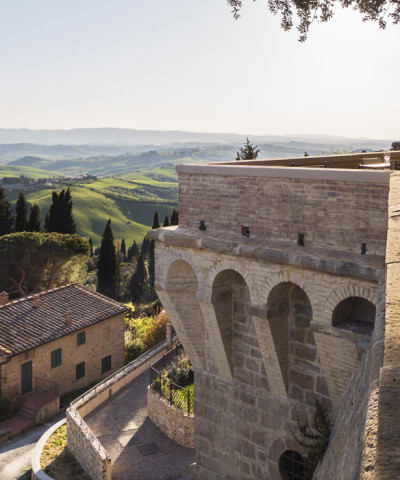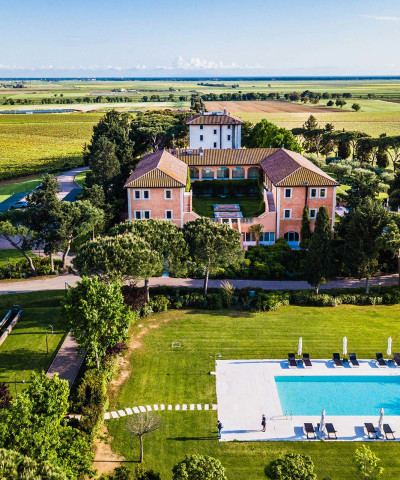The Tuscany of the Medici Villas
A priceless world heritage
When Giusto Utens was called upon by Ferdinando I, at the end of the 1500s, to paint the series of lunettes depicting the heritage of the Medici villas, the Medici family's fortune was at the peak of its splendour, and Utens painted 17 lunettes characterized by an avant-garde view from above. The radius of the property spanned from the Mugello to the Arno plains, toward Pisa and Livorno, forming a hypothetical fan open to the north-west from Florence.
From this symbolic universe that sums up the power, size and passions of the Medici (many were hunting lodges), the austere Ferdinanda was the ideal centre, and was chosen to house the Utens miniatures. We begin with these small treasures and go on to tell the story of five of these wonders - Villa La Petraia, Villa Corsini di Castello, Villa di Poggio a Caiano and Villa di Cerreto Guidi, which also came to include the garden of the Villa di Castello – once again managed by the Museums of Florence by government decree. Then it was called reconciliation.
It was 2002 and the history of these places took the course that had been theirs for centuries: these residences had always been the palaces in the area, governed by the same administrative logic, use and collecting. To sum it up, a tear that was stitched together again. The lunettes are also recently back in the capital again and are currently preserved in the Villa Petraia. Today we can see four of them. The others require minor surgery and some conservation work and will be exhibited later. But the lunettes are the main reason that La Petraia and the other villas of the Florentine Museums deserve a visit.
La Petraia is one of the most fascinating Medici villas for its fine position, the excellence of the paintings and the mix of forms and styles. The villa was originally an ancient fortified palagio that belonged to the Brunelleschi family. It was purchased by Cosimo I in 1544, and then given to his son Ferdinando. Appointed Grand Duke at the sudden death of his brother Francesco, in 1588 Ferdinando began work in the villa to suit it to his role and the dynasty to which he belonged. The renovations involved the beautiful garden more than the structure of the villa, attributed to Buontalenti.
Major earthworks transformed the stony nature of the place into a spectacular series of terraces occupied by dwarf orchards, medicinal plants, evergreens and a large pond in front of the villa used as a water reservoir. This is the external image of the Villa as it is depicted by Utens. Today the garden has a nineteenth-century plan, but is no less charming. The famous sculpture Venere-Fiorenza by Giambologna can be admired in the garden in the form of a copy, while the original is kept inside the villa itself, in what is called the Studiolo di Fiorenza.
The interiors, especially the entirely frescoed courtyard, are breath-taking. Here the works from the late 1500s and 1600s by Goffredo Daddi and Baldassare Franceschini, called the Volterrano, tell the epic story and glories of the Medici. The roof of iron and glass and the floor are more recent, from 1872, but in perfect harmony with the structure. The series of rooms on the first and second floor do not disappoint, and house pictures and that range from the late 1500s to 1800.
The Villa di Castello is one of the oldest suburban residences of the Medici family, and was in fact purchased in 1477. The preferred dwelling of Cosimo I, special care was taken with it and its garden, designed in 1538, a year after the young duke’s rise to power, was designed to celebrate the power of the prince through the symbology of its statues, fountains and grottos. Today the villa is home to the Accademia della Crusca and can be visited only on the days it is open to the public.
Instead, the beautiful garden is open. It is full of citrus trees and rare plants, decorated with ancient and Renaissance sculptures and divided into three main areas: the lower garden, the upper garden - where the sculpture called Dell’Appennino by Ammannati is located - and Ortaccio, the walled garden. The Grotta degli animali, also known as del Diluvio, for its amazing water features, is also very charming. Started by Niccolò Tribolo, it was completed in 1538 by Vasari, 50 years later.
Villa Corsini or ‘I Rinieri’ (named after the sixteenth-century owners), located at the city gates to the west in Castello, was purchased in 1697 for its proximity to the Medici Villa La Petraia by the Councillor of Grand Duke Cosimo III, Filippo Corsini, who entrusted the reconstruction to Giovan Battista Foggini. In 1968 the villa was donated to the Italian State by Galliano Boldrini and in 2006 became part of the circuit of the Superintendence for the State Museums of Florence.
In the great hall some of the most significant marble pieces from the collection of the Archaeological Museum are located, including the extraordinary statue of Ariadne sleeping, a Roman copy of an original created at the beginning of the second century BC in a workshop of Pergamon or Rhodes. It belonged to the collection of Cardinal Ferdinando de’ Medici. There is also a statue of the unhappy son of Niobe who had dared to defy the gods, a replica of a work exhibited in the Uffizi Gallery, and the colossal bust of Hercules already in Palazzo Portinari Salviati in Via del Corso.
The story of the Medici Villa at Poggio a Caiano begins with the purchase of a large area of land in the area between Bonistallo and Tavola by Lorenzo the Magnificent. It was 1474 and Lorenzo himself commissioned the villa, which was built to a design by Giuliano da Sangallo on the slopes of Mount Albano. Construction stopped with the death of Lorenzo in 1492, and began again at the behest of Pope Leo X, son of Lorenzo. The work was completed in the second half of the sixteenth century. The villa, high on a portico, is open on all sides towards the garden and the surrounding landscape.
The beating heart of the building is the hall on the first floor, called Leone X, beautifully decorated with allegorical frescoes celebrating the Medici family, by Andrea del Sarto, Pontormo, Franciabigio, and Alessandro Allori. The villa is also linked to some of the dynasty’s well-known love stories: Francesco lived here with Bianca Cappello, first his lover and then wife – whose apartment you can still see on the ground floor - and where Cosimo III, almost a century later, kept his rebel bride, Marguerite Louise D’Orléans, in gilded exile.
The Villa di Cerreto Guidi, located near the Fucecchio marshes, an area particularly rich in fauna, was built in 1556 for Cosimo I as a hunting lodge and local headquarters. The design of the building is attributed to Buontalenti and is characterized by two stairway ramps in the front of the villa. Inside there are portraits of the Medici family and furniture from various periods, some dating back to 1800 and from legacies of well-known Florentine antique collectors like Stefano Bardini.










